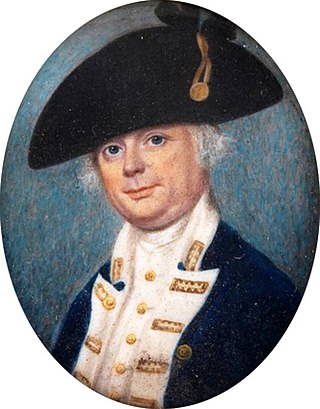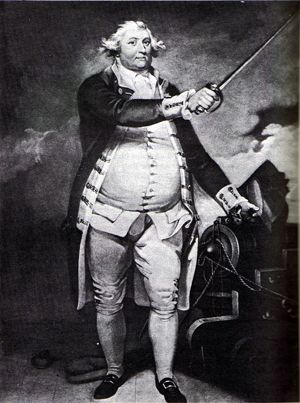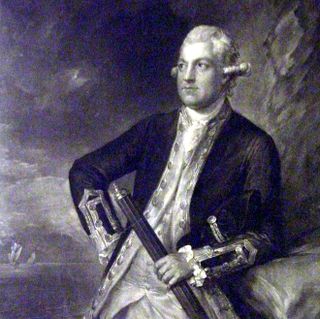
Admiral George Brydges Rodney, 1st Baron Rodney, KB, was a British naval officer. He is best known for his commands in the American War of Independence, particularly his victory over the French at the Battle of the Saintes in 1782. It is often claimed that he was the commander to have pioneered the tactic of breaking the line.

The North America and West Indies Station was a formation or command of the United Kingdom's Royal Navy stationed in North American waters from 1745 to 1956, with main bases at the Imperial fortresses of Bermuda and Halifax, Nova Scotia. The North American Station was separate from the Jamaica Station until 1830 when the two combined to form the North America and West Indies Station. It was briefly abolished in 1907 before being restored in 1915. It was renamed the America and West Indies Station in 1926. It was commanded by Commanders-in-Chief whose titles changed with the changing of the formation's name, eventually by the Commander-in-Chief, America and West Indies Station.

Francis William Drake was an officer of the Royal Navy. He served during the War of the Austrian Succession, the Seven Years' War and the American War of Independence, rising to the rank of vice-admiral of the red.

The Commander-in-Chief, The Nore, was an operational commander of the Royal Navy. His subordinate units, establishments, and staff were sometimes informally known as the Nore Station or Nore Command. The Nore is a sandbank at the mouth of the Thames Estuary and River Medway. In due course the Commander-in-Chief became responsible for sub-commands at Chatham, London, Sheerness, Harwich and the Humber.

Admiral Sir William Parker, 1st Baronet, was a British naval commander.
Admiral Sir Francis Laforey, 2nd Baronet, KCB was an officer of the British Royal Navy during the French Revolutionary and Napoleonic Wars, whose distinguished service record included numerous frigate commands in Home waters and in the West Indies. He is best known however for his service in command of the ship of the line Spartiate at the Battle of Trafalgar in 1805. During the action, Laforey was heavily engaged and his ship suffered heavy casualties. Five years after Trafalgar, Laforey was promoted to rear-admiral and commanded the Leeward Islands squadron, before retiring in 1814.

Rear Admiral Sir Charles Douglas, 1st Baronet was a descendant of the Earls of Morton and a distinguished British naval officer. He is particularly known for his part in the Battle of the Saintes during the American War of Independence where he helped pioneer the tactic of "breaking the line".
Admiral Sir John Laforey, 1st Baronet was a senior and controversial British naval officer of the 18th century whose extensive career was spent mainly on the North American and West Indian stations. During his career, Laforey was repeatedly involved in contentious naval politics, especially relating to the provision of prize money and angered several senior officers through much publicised disputes. This resulted in his sidelining for much of his career, only making flag rank and finding success with the outbreak of the French Revolutionary Wars in 1793.

Sir Charles Thompson, 1st Baronet was a British naval officer. After long service in the Seven Years' War, American War of Independence and War of the First Coalition, he was Admiral John Jervis's second in command at the battle of Cape St Vincent. However, his disregard for Jervis's signal to tack to counter a Spanish attacking move nearly lost the battle, and began an enmity with Jervis that eventually led to Thompson's retirement. From 1796 to 1799 he was also MP for Monmouth.
Vice-Admiral Sir William Charles Fahie KCB was a prominent British Royal Navy officer during the American War of Independence, French Revolutionary War and the Napoleonic Wars. Unusually, Fahie's service was almost entirely spent in the West Indies, where he had been born and where he lived during the time he was in reserve and in his retirement. After extensive service in the Caribbean during the American War of Independence, during which Fahie impressed with his local knowledge, Fahie was in reserve between 1783 and 1793, returning to service to participate in Sir John Jervis' campaign against the French West Indian islands in 1794.

Sir Hugh Cloberry Christian KB was an officer of the Royal Navy who saw service during the American War of Independence, and the French Revolutionary Wars.

The Commander-in-Chief, Plymouth, was a senior commander of the Royal Navy for hundreds of years. Plymouth Command was a name given to the units, establishments, and staff operating under the admiral's command. Between 1845 and 1896, this office was renamed Commander-in-Chief, Devonport. The Commanders-in-Chief were based in what is now Hamoaze House, Devonport, Plymouth, from 1809 to 1934 and then at Admiralty House, Mount Wise, Devonport, from 1934 until 1996.

Charles Inglis was an officer of the Royal Navy who saw service during the War of the Austrian Succession, the Seven Years' War, and the American War of Independence, rising to the rank of rear-admiral.
Sir William Burnaby, 1st Baronet was a British naval officer who became Commander-in-Chief, Jamaica Station.

The Jamaica Station was a formation or command of the United Kingdom's Royal Navy stationed at Port Royal in Jamaica from 1655 to 1830.

The Glorious Revolution of 1688 rearranged the political map of Europe, and led to a series of wars with France that lasted well over a century. This was the classic age of sail; while the ships themselves evolved in only minor ways, technique and tactics were honed to a high degree, and the battles of the Napoleonic Wars entailed feats that would have been impossible for the fleets of the 17th century. Because of parliamentary opposition, James II fled the country. The landing of William III and the Glorious Revolution itself was a gigantic effort involving 100 warships and 400 transports carrying 11,000 infantry and 4,000 horses. It was not opposed by the English or Scottish fleets.
The Downs Station also known as the Commander-in-Chief, the Downs or Admiral Commanding at the Downs was a formation of the Kingdom of Great Britain and then the United Kingdom's Royal Navy based at Deal. It was a major command of the Royal Navy from 1626 until 1834.
The Commander-in-Chief, Leith formally known as the Commander-in-Chief at Leith and on the Coast of Scotland was a military commander and formation of the Royal Navy from 1745 to 1825.

Admiral Thomas Dumaresq was an officer in the British Royal Navy that rose to the rank of Admiral. Dumaresq was notable for his role as Captain of HMS Repulse in the Battle of the Saintes during the American Revolutionary War.
Admiral Thomas Le Marchant Gosselin was a British naval officer of the 18th and 19th centuries who received the patronage of senior officers such as Samuel Hood, 1st Viscount Hood and William Cornwallis. Gosselin joined the Royal Navy in 1778 and as a junior officer had extensive service in the American Revolution, including participating in the Battle of the Saintes in April 1782. Promoted to commander in April 1793, Gosselin took part in the Glorious First of June as commander of HMS Kingfisher. He was promoted to post-captain in July 1795 and took command of a variety of ships including most notably HMS Syren, HMS Latona, and HMS Audacious. Gosselin frequently served on blockade duties in the English Channel and on convoy duties to and from the West Indies.













